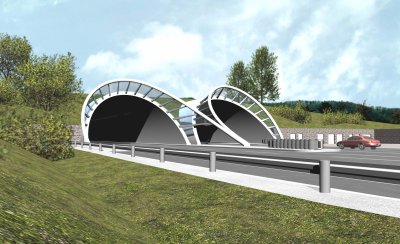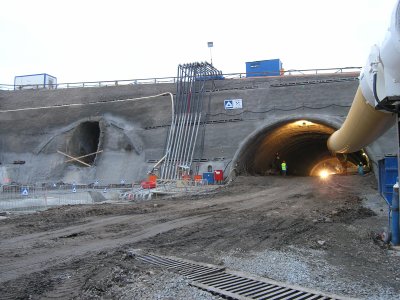Slivenec Tunnel
Slivenec Tunnel
Prague City Ring Road, construction lot 514 Lahovice - Slivenec
Owner:
Directorate of Roads and Motorways of the Czech Republic, Prague Plant
Na Pankráci 56
Praha 4
Contractor:
Consortium STRABAG – HOCHTIEF-BŐGL
HOCHTIEF
Primátorská 36/323
180 00 Praha 8
Consulting Engineer:
METROPROJEKT Praha a.s.
I.P.Pavlova 2/1786
120 00 Praha 2
Valbek spol.s r.o.
Vaňurova 505/17
460 01 Liberec
Tubes spol. s r.o.
K Ryšánce 1668/16
147 54 Praha 4
Construction Period:
Commencement of Works: 10 / 2006
Commissioning (testing operation) : 04 / 2010
|
Basic data |
2-lane descending tunnel |
3-lane ascending tunnel |
|
Tube length |
1629 m |
1651 m |
|
Mined part length |
1262 m |
1294 m |
|
Cut-and-cover parts length |
367 m |
357 m |
|
Number of escape corridors |
7 |
7 |
|
Number of lay-bys |
1 |
0 |
|
Longitudinal gradient |
4.00% |
4.00% |
|
Transverse gradient |
2.50% |
2.50% |
|
-4.00% |
-4.00% |
|
|
3.50% |
3.50% |
|
|
Theoretical excavated cross sectional area |
89.68 / 102.84 m2 |
101.63 / 125.06 m2 |
|
Exploration gallery profile area |
20.8 |
Geology :
The downhill drive consecutively encountered series of Lower Silurian and Upper Ordovician strata; general NW dip of the strata. The rock mass is seriously disturbed by pervasive faults and folds.
The Kopanina Member is faccially very chequered; it consists of calcareous shales alternating with limestone, or tuffitic claey shales and basaltic tuff.
The records contain clayey shales, calcareous, slightly weathered, moderately weathered – R4, massive, dark brown-grey R3, tabular beds with micritic limestone interlayers, grey - R2 and tabular beds of clayey tuffitic shale, calcareous, dark brown-grey, massive – R3 with thicker layers of basaltic tuffs, green-grey, forming tabular to platy beds – R2 15m thick.
The Motol Member consists mainly of basal clayey to clayey-silty shales, grey-black – R3, forming tabular to platy beds, with secondary layers of bituminous limestone - R2, forming tabular beds.
The Kosov Member (the Upper Ordovician) represents a lithologically chequered sequence of rocks from shales, siltstone and greywacke to quartzose sandstone. About 2m thick layer of coarsely-grained sandstone to agglomerate was encountered on the Member base. Rock types frequently alternate.
The shales are clayey, forming laminas to thin tables, grey to green-grey, heavily micaceous. Light-grey to brown siltstone and sandstone have usually a sheeting structure.
The Králův Dvůr Member (the Upper Ordovician) consists of clayey shales, forming thin plates to laminas, non-micaceous or very finely micaceous, grey to grey-green, easily weathering on the surface, decomposing to clayey eluvium. The highest part of the Králův Dvůr Member has the character of grey claystone.
Hydrogeological conditions :
They are affected by an exploration gallery. The drainage effect of the gallery lowered the water table in the vicinity; it was at the level of the bottom of the gallery in the mined tunnel profiles.
Tunnel driving :
Downhill from the Slivenec (upper) portal by means of the NATM, using a top heading, bench and invert excavation sequence. The drill and blast technique was applied, using modern, high performance wheeled equipment.
NATM excavation support classes 3, 4, 5a, 5b . Temporary invert was even in the top heading at the portal, NATM class 5a.
Primary lining elements
· welded mesh 6/150/150 mm
· lattice girders
· C20/25 X0 sprayed concrete, 250 - 350mm thick layer, wet process
· rock bolts expanded by pressurised water 4.0 or 6.0 m long in the top heading; SN anchors 4.0m or 6.0m long in the bench; adequately long IBO anchors were used in the cases of instable boreholes
Final tunnel lining :
Cast-in-situ reinforced concrete; 400mm thick in the three-lane tunnel, 350mm thick in the double-lane tunnel; concrete grade C25/30 XF4, XD3;
The individual blocks are 12m long in the crown, which represents casting of about 165m3 of concrete per block in the three-lane tunnel
The umbrella type waterproofing system consists of intermediate 2.5mm thick PE membrane and longitudinal drains.




